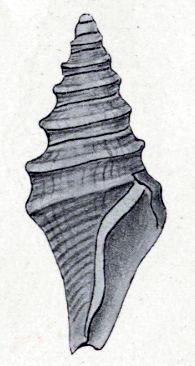Paracomitas protransenna facts for kids
Quick facts for kids Paracomitas protransenna |
|
|---|---|
 |
|
| Original image of a shell of Paracomitas protransenna | |
| Scientific classification | |
| Synonyms | |
|
† Surcula protransenna P. Marshall & Murdoch, 1923 |
Paracomitas protransenna was a type of sea snail that lived a long time ago. It is now extinct, meaning it no longer exists on Earth. This ancient sea snail was a mollusk, just like modern snails and clams. It belonged to a group of sea snails called the Pseudomelatomidae family. Scientists first described this species in 1923.
What did Paracomitas protransenna look like?
The shell of Paracomitas protransenna was quite small. It grew to about 13 millimeters (or half an inch) long. The widest part of the shell was about 5 millimeters across.
The shell had a narrow, spindle-like shape. It had a pointy top, which is called the spire. The shell was made up of seven or eight whorls, which are like the spiral turns you see on a snail shell.
A cool feature of its shell was a strong, rounded ridge or "keel" in the middle of each spiral turn. Below this main ridge, there was often a second, less noticeable ridge. The shell narrowed quickly towards the front.
The opening of the shell, called the aperture, was oval-shaped. From this opening, a long tube-like part extended, known as the siphonal canal. This canal was used for breathing and feeding. The very first part of the shell, called the protoconch (like a baby shell), was smooth and had a blunt tip.
The shell also had fine spiral lines as part of its pattern. These lines were sometimes hard to see. There were also growth lines, which show how the snail grew over time.
Where did Paracomitas protransenna live?
This extinct sea snail lived only in New Zealand. This means it was endemic to that area. It was not found anywhere else in the world.

